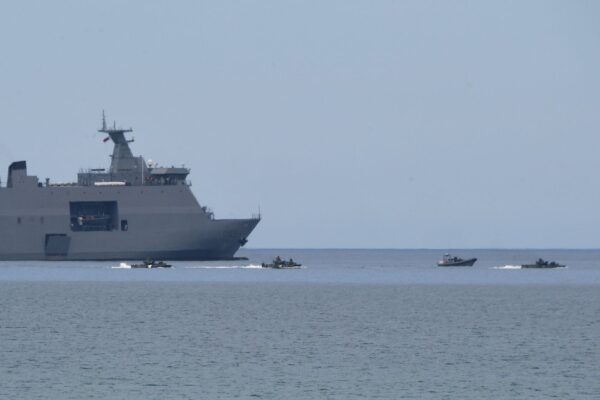The United States will help to modernize Philippine military capabilities and revive joint patrols in the South China Sea, which had been stalled during the previous Duterte administration, the U.S. defense chief said on Thursday.
The move was announced following a meeting between U.S. Defense Secretary Lloyd Austin, Philippine President Ferdinand Marcos Jr., and Secretary of National Defense Carlito Galvez in Manila on the same day.
Austin described the Philippines as “a key ally” with which the United States would seek to strengthen ties “in every way possible,” according to a statement issued by the U.S. Defense Department.
“We conduct more than 500 defense engagements together every year,” he told a joint press briefing. “And as President [Joe] Biden has made clear, America’s commitment to the defense of the Philippines is ironclad.”
Austin and Galvez also reaffirmed the mutual defense treaty commitments, with the U.S. defense chief saying it applies to armed attacks on either country’s defense assets in the West Philippine Sea—the name that Manila uses for the South China Sea.
“We discussed concrete actions to address destabilizing activities and the waters surrounding the Philippines, including the West Philippine Sea, and we remain committed to strengthening our mutual capacities to resist armed attack,” Austin said.
He said the United States would help modernize the Philippine military and boost interoperability between their forces.
Austin said these “efforts are especially important as the People’s Republic of China continues to advance its illegitimate claims in the West Philippine Sea.”
Both sides agreed to restart joint maritime patrols in the disputed sea, reviving the activities that former Philippine President Rodrigo Duterte suspended in April 2016 to strengthen ties with Beijing.

Marcos, who took office in June 2022, has been keen to bolster the U.S.-Philippines alliance. During his meeting with Austin, Marcos expressed his intention to maintain ties with Washington, citing the United States’ role as “a Pacific power.”
“More specifically here, the Asia-Pacific region has become a terribly complicated situation,” he remarked. “It is something we can only navigate with the help of our partners and our allies.”
The United States also secured four new military bases in the Philippines under the Enhanced Defense Cooperation Agreement (EDCA), which was signed in 2014. It remains unclear where the new EDCA sites would be.
The new four locations join five existing EDCA sites, for which the United States has allocated more than $82 million in infrastructure investments. At these five Philippine military camps, U.S. forces could rotate indefinitely.

Geopolitical Rivalry
The Chinese Embassy in Manila condemned Austin’s meeting with the Philippine government and accused him of trying to advance the “anti-China political agenda” of the United States by “smearing China” on the South China Sea issue.
“It is hoped that the Philippine side stays vigilant and resists from being taken advantage of and dragged into trouble waters,” the Chinese embassy said in a statement.
Beijing claims much of the South China Sea as its own under its so-called “nine-dash line.” The Hague Tribunal ruled in favor of the Philippines in 2016. Still, it has had little to no impact on Beijing’s behavior, with it repeatedly intruding into Manila’s territorial zones.
The Philippines sought to increase its military presence in the South China Sea to deter the Chinese from encroaching on its territories. The Southeast Asian nation is also concerned about Beijing’s aggression against Taiwan, given its proximity to the self-ruled island.
Marcos said on Jan. 16 that the Association of Southeast Asian Nations (ASEAN) is facing “strong pressure” from major powers to choose sides amid geopolitical rivalry in the Indo-Pacific region.
“The forces of us going back to that Cold War type of scenario, where you have to choose one side or the other, are strong,” Marcos told reporters in Switzerland, according to the state-run Philippine News Agency.
“I think we are determined as a group in ASEAN and in the Indo-Pacific, those around the Indo-Pacific, despite all of this conflict, we are determined to stay away from that.”
Mimi Nguyen Ly contributed to this report.

IL PRIMO ECOMMERCE SPECIALIZZATO IN DELIZIE AL TARTUFO E CAVIALE – CAVIAREAT.COM
